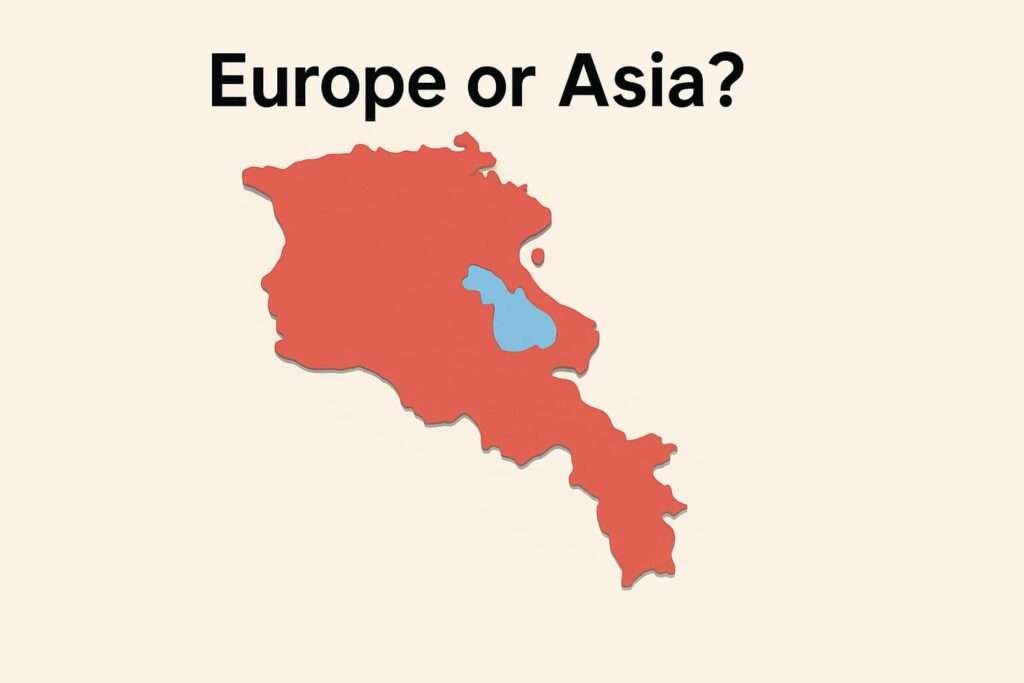Armenia is geographically in Western Asia (South Caucasus) under most scientific schemes, including the UN’s statistical regions. However, Armenia participates deeply in European institutions (Council of Europe, UEFA, Bologna/EHEA, EU’s Eastern Partnership), so many describe it as a transcontinental or “Eurasian” country with strong European ties.
The Short Answer & Why It’s Tricky
Strictly by physical geography, Armenia lies south of the Greater Caucasus crest, which many geographers use as the Europe–Asia dividing line. That places Armenia in Western Asia. Encyclopaedia Britannica even describes Armenia as fronting the “northwestern extremity of Asia.”
But classification is not just rocks and ridgelines. Armenia votes in the Council of Europe, competes in UEFA football, sends entries to Eurovision, and reformes higher education under the Bologna Process. In day-to-day life—sports, media, law—many experiences feel “European.” That’s why you’ll hear both labels, depending on context. (Links below lead to official pages for those bodies.)
The geographic definition vs. lived reality
Geographic regions help us organize maps; institutions shape identity and cooperation. Armenia straddles both ideas: West Asian by landform; European-leaning in many organizations. Understanding the two lenses removes the “either/or” trap.
| Lens | Where Armenia Fits | Why |
|---|---|---|
| Physical geography | Western Asia (South Caucasus) | South of the Greater Caucasus watershed |
| Political & cultural | European-leaning | Council of Europe, UEFA, EHEA, Eurovision participation |
Where Armenia Is on the Map (and Why It Matters)
Armenia is a landlocked country in the South Caucasus. It borders Turkey to the west, Georgia to the north, Azerbaijan to the east (including the Nakhchivan exclave to the southwest), and Iran to the south. The terrain is largely highland; the capital, Yerevan, sits on plateaus framed by volcanic mountains.
Key numbers help fix it in place. Area: 11,484 sq mi (29,743 km²). Highest point: Mount Aragats at 13,418 ft (4,090 m). Lake Sevan, one of the world’s largest high-altitude lakes, lies at about 6,250 ft (1,905 m)</strong). These figures anchor Armenia firmly within the rugged Lesser Caucasus and Armenian Highlands—again, south of the Europe–Asia ridge.
Borders, relief, and key numbers
Mountains, valleys, and high lake basins dominate. The high ground explains Armenia’s cool winters and mild summers compared with nearby lowlands. As a landlocked state with only two consistently open trade borders (Georgia and Iran), geography shapes its economy and diplomacy.
The South Caucasus explained
The Caucasus is the neck of land between the Black and Caspian seas. It contains two main mountain chains: the Greater Caucasus (to the north) and the Lesser Caucasus (to the south). Armenia lies wholly in the south—what many call Transcaucasia or the South Caucasus.
| Metric | Value |
|---|---|
| Total area | 11,484 sq mi (29,743 km²) |
| Highest point | Mount Aragats — 13,418 ft (4,090 m) |
| Major lake (elev.) | Lake Sevan — 6,250 ft (1,905 m) |
| Neighbors | Georgia (N), Azerbaijan (E), Iran (S), Turkey (W) |
Politics & Culture: How “European” Is Armenia Institutionally?
Council of Europe: Armenia has been a full member since 25 January 2001, voting alongside other European democracies on human rights and rule-of-law standards.
UEFA football and Eurovision (EBU) participation further embed Armenia in European sports and media. In higher education, Armenia is part of the European Higher Education Area (Bologna Process), hosting the 2015 ministerial in Yerevan. These memberships don’t change geography—but they do shape perceptions.
EU ties (CEPA, Eastern Partnership)
Armenia’s deep legal-policy ties with the EU are framed by the EU–Armenia Comprehensive and Enhanced Partnership Agreement (CEPA), signed in 2017 and in force since 1 March 2021, and by the EU’s Eastern Partnership. These instruments align many standards—from trade to governance—closer to the EU acquis, even though Armenia is not an EU member.
| Body / Agreement | What it is | Armenia’s status |
|---|---|---|
| Council of Europe | Pan-European human rights & democracy body | Member since 25 Jan 2001 |
| UEFA | European football confederation | Member association; plays in European competitions |
| Bologna / EHEA | European Higher Education Area reforms | Participating; hosted 2015 ministerial |
| EU CEPA | EU–Armenia legal framework | Signed 2017; in force 1 Mar 2021 |
International Classifications: UN Geoschemes vs. UN Regional Groups
There are two common UN-related ways Armenia gets labeled, and they serve different purposes.
UN M49 geoscheme (statistics): Armenia is grouped in Western Asia for statistical reporting—this is a geography-based region set. Britannica’s geography entry supports the “northwestern Asia” description as well.
UN Regional Groups (diplomacy): At the UN General Assembly, Armenia belongs to the Eastern European States group (EEG), which helps allocate seats and coordinate diplomacy. So, in UN politics Armenia aligns with Europe; in UN statistics it sits in Asia.
Practical Takeaways for Students, Travelers, and Quiz-takers
In class or quizzes: If the question is purely geography, “Asia/Western Asia” is usually the expected answer. If the question is about institutions (football, human rights courts, higher education space), “European” participation is correct. Always read how the question defines its terms.
In guides and atlases: Some publishers file the Caucasus under “Europe,” others under “Asia,” and many under a neutral “Eurasia/Caucasus.” Britannica prefers a geography-first approach, placing the ranges in Asia while acknowledging the historical debate around the watershed.
FAQ
So, what should I answer in one sentence?
“Armenia is geographically in Western Asia (South Caucasus) but participates widely in European institutions.” That’s accurate and works for most contexts.
Does Armenia compete in European sports?
Yes. Armenia is a UEFA member, so national and club teams play in European competitions and qualifiers.
Is Armenia moving closer to the EU?
Legally and economically, yes: the EU–Armenia CEPA (signed 2017) has been fully in force since 1 March 2021, deepening cooperation without full membership.
What Did We Learn Today?
- By the common watershed convention, Armenia lies in Western Asia, south of the Greater Caucasus crest.
- Armenia’s institutions lean European: Council of Europe, UEFA, EHEA, Eurovision.
- The UN’s statistical geoscheme puts Armenia in Western Asia; its UN regional group is Eastern European States.
- Core facts: area 11,484 sq mi (29,743 km²); Mount Aragats 13,418 ft (4,090 m); Lake Sevan 6,250 ft (1,905 m).
- EU ties were upgraded by CEPA, in force since 1 March 2021.





